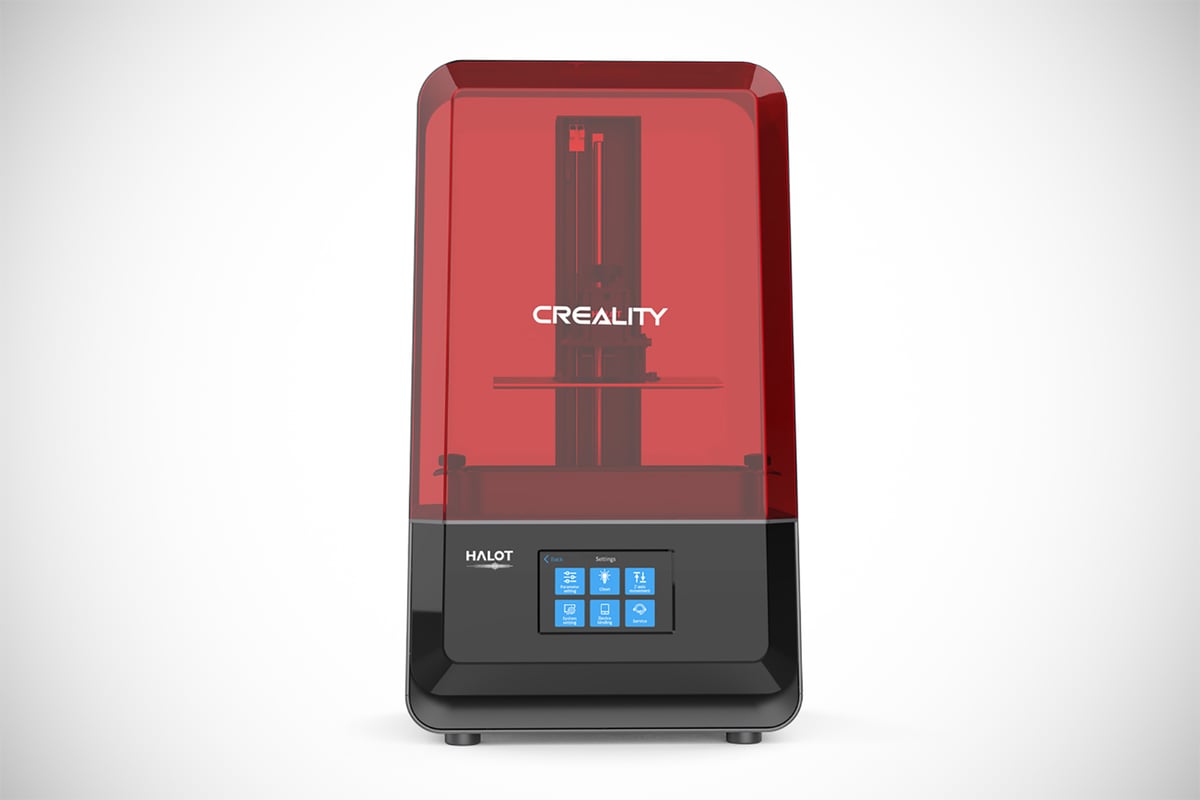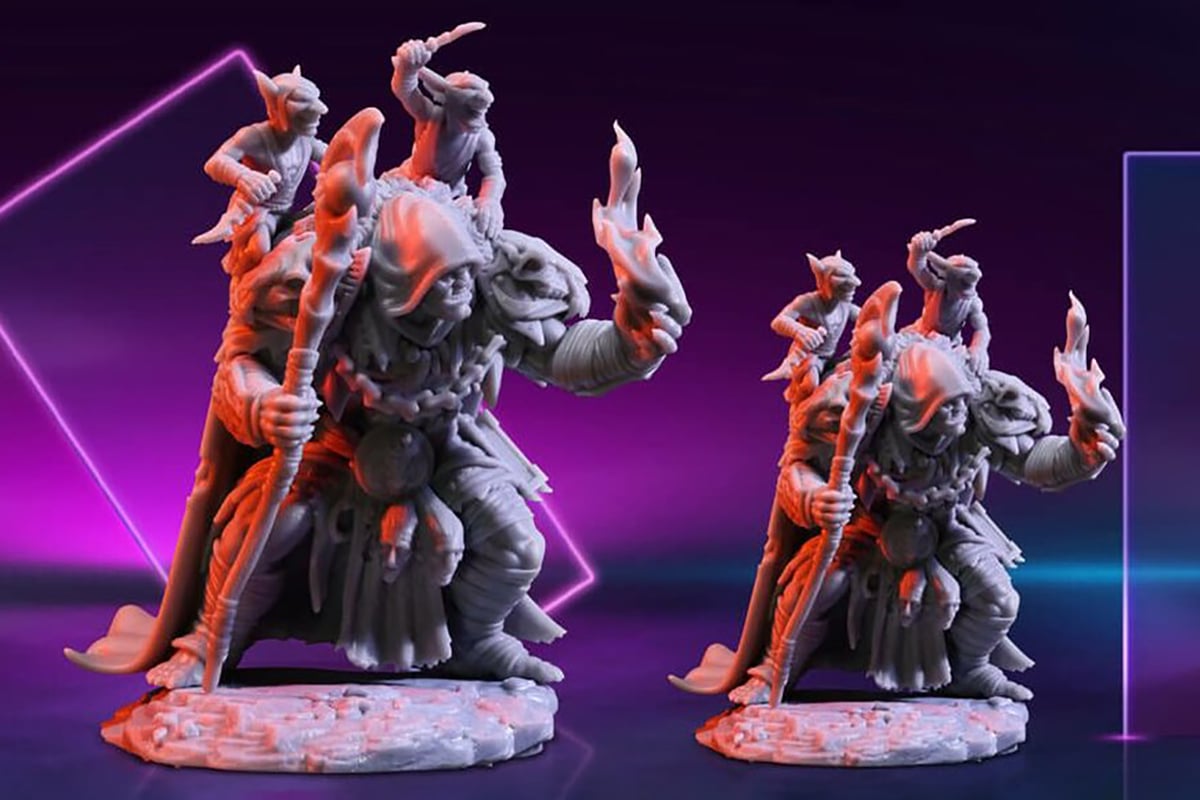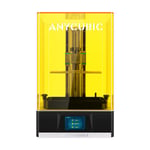Well, Halot there. Following the release of the Halot Sky and Halot One, Creality has released a third Halot series printer: the Halot Lite.
A mid-size desktop resin 3D printer that looks set to go toe to toe with the likes of the Elegoo Saturn. But does it have what it takes to land a few punches, or is this yet another Creality printer, a featherweight destined to hit the canvas?
Creality is certainly making some noise about the Halot Lite, partnering with Cults to run a 3D modeling architecture contest – the prize being, of course, a Halot Lite printer.
To help see if it’s all that, we’ve scraped together what we can to build up the full picture of what the Halot Lite is and can do.
Read on to find out.
Features

And so we go again with Creality. The Halot Lite will be the third such Halot machine to release in 2021 and will fit right in the middle of the company’s lineup in terms of build volume and, cost.
Build volume
There are two critical factors in budget resin 3D printing you typically consider before making the purchasing decision. The first is build volume. LCD-based 3D printers today are available in all shapes and sizes (and colors, but that’s a different story).
The Halot Lite is a middleweight in terms of build volume, with 192 x 120 x 200 mm of printing space at its disposal. Larger than the Halot One or, say, the Elegoo Mars 3, but smaller than huge printers such as Phrozen’s Sonic Mega 8K and the upcoming Elegoo Jupiter.
The Halot Lite, despite the name, stacks up against the Elegoo Saturns, Phrozen Sonic Mighty 4Ks, and Anycubics Mono Xs of the world – all mid-to-large-sized resin 3D printers.
Resolution

Coinciding with the build volume is the print resolution. LCD-based 3D printers work by illuminating a mask of pixels, curing thin crosssections of a model layer by layer until the complete object forms.
To achieve higher detail prints, you need more pixels to give finer definition to the outside of your print. The larger the build area, the more pixels the mask (read: LCD) needs. The Halot Lite features 3840 x 2400 pixels, 4K, if you will, which pans out to an XY accuracy of 50 microns across its 192 x 120 mm build area. This is on par with the other mid-size resin 3D printers, including the Elegoo Saturn, available for close to a year now.
Is this resolution good enough? We’d argue that yes, it is. Prints composed of 50 micron-sized voxels are more than fine enough for outstanding detail to the naked eye. Professionals and prints that demand it can, of course, benefit from finer resolutions such as those found on printers like the Elegoo Mars 3. But for plain and simple recreational printing, we’d be content with what the Halot Lite offers.
Not forgetting, of course, that the Halot Lite features a monochrome LCD, meaning it prints fast – mere seconds per layer – and has a longer lifespan compared to non-mono LCDs found on older printers.
Halot light source

Besides build volume and resolution, the light source – also referred to as the light engine – is another crucial element in an LCD-based 3D printer.
Creality developed a new light source for the Halot series of printers, meaning that the Halot Lite also carries this… light. Consisting of 12 lamp beads, each composed of four light-emitting chips, Creality claims this system guarantees a light uniformity of more than 80% across the whole print bed. According to Creality, this means no more problems such as uneven curing across the build area and high precision to improve the delicacy and gloss of the model.
Wi-Fi connectivity
What a treat; Wi-Fi connectivity means more time spent away from the printer and smelly resin. You can, of course, resort to a USB stick for file transfer, but the option to go remote could be a welcome convenience.
Besides remote control, Creality claims the Wi-Fi functionality allows for “one-click” upgrades to the firmware and integration with the company’s Creality App and Cloud platform. With the app, you can monitor your prints’ status in real-time if you’re away from the printer and/or can’t muster the energy to go and have a look yourself.
CPU
Creality’s Halot series of printers use ARM Cortex CPUs, silicon designed and made by the British manufacturer ARM. These chips are more commonly found running modern gizmos like smartphones, Amazon Echo devices, and mobile game consoles such as the Nintendo Switch.
With it, we should see some strong and smooth performance in the Halot Lite. Alongside the 64-bit quad-core high-performance motherboard, the Lite promises high computing and imagery processing power to ensure consistent printing accuracy.
Halot Box Slicer
Alongside the Halot series, Creality also released new slicing software, Halot Box. A simple, straightforward, smartly dressed little slicer. At release alongside the Halot Sky and Halot One, Halot Box lacked vital functions for slicing for resin 3D printing, such as hollowing and the ability to create holes in prints. Recent updates have brought the slicer up to par, though, with it comfortably capable for the fundamentals of resin printing alongside popular software such as Lychee or ChiTuBox.
For anyone wanting a bit more sophisticated appearance for their slicer and some more advanced settings, the Halot Lite is also compatible with Lychee, including wireless functionality.
Activated carbon filter
Last but not least, the Creality Lite features an activated carbon air filtration system located towards the back of the printer. Keep in mind that resin 3D printing stinks. You should only print in a well-ventilated space, filter or not, but the activated carbon filter should positively impact the resin fumes from within the printer. At least, for the duration of the carbon’s service life – it will need to be replaced at some point.

Release Date & Availability
The Halot Lite was announced in late September 2021 and is the third and latest addition to Creality’s Halot series. At the time of writing, Creality has just released a limited pre-order on its website. For further information regarding full product launch, best monitor the company’s social media channels or homepage.

Price
The first batch of Halot Lites is available for $579, although with only a handful available. We can only guess whether this will be the asking price once the printer is fully available, but pre-order prices generally tend to be a bit lower than over-the-counter price tags.
Compared against similar printers, our lowball guess is just short of $600. Throw in the Wi-Fi connectivity and the overall “newness,” and perhaps $650 is closer to the truth. Again, we don’t know – just a guess.

Tech Specs

General Specifications
- Technology: MSLA
- Type: Resin
- Year: 2021
- Assembly: Fully-assembled
- Manufacturer: Creality
3D PRINTING SPECIFICATIONS
- Build Volume: 192 x 120 x 200 mm
- Layer Height: 10 microns
- XY Resolution: 50 microns ( 3840 x 2400 pixels)
- Z-axis positioning accuracy: N/A
- Printing Speed: 1-4 seconds/layer
- Bed-Leveling: Manual
- Display: 5-inch touchscreen
- Third-Party Materials: Yes
- Materials: 405 nm UV resin
SOFTWARE REQUIREMENTS
- Recommended Slicer: Halot Box slicer, Lychee
- Operating system: Windows / macOS X / Linux
- File types: STL
- Connectivity: USB, Wi-Fi
DIMENSIONS AND WEIGHT
- Frame dimensions: 330 x 300 x 572 mm
- Weight: 10,6 kg
- Boxed size: N/A
- Weight (packed): N/A

Similar Printers
Only testing will tell if the Creality Halot Lite will be a strong enough proposition to make it into the ranks of our favorite large resin 3D printers. Our guide to the best large resin printers has all of our current recommendations on hand to help you find the right printer.
Anycubic Photon Mono X
Thanks to its speedy, detailed prints and large build volume, the Anycubic Photon Mono X is a printer we’re a big fan of. It has more build height than the Creality Halot Lite will, but the X and Y are identical. One thing we’ll be hoping for, though, is that the Wi-Fi on the Halot Lite is more useful than on the Photon Mono X. (Hit the review link below for more on that.)
Phrozen Sonic Mighty 4K
The Sonic Mighty 4K is Phrozen’s crack at the mid-large resin 3D printer. It offers a slightly larger build volume of 200 x 125 x 220 mm but misses some conveniences. Wi-Fi connectivity, for example, is absent. Priced at ~$500, it is an affordable alternative.
License: The text of "Creality Halot Lite: Specs, Price, Release & Reviews" by All3DP is licensed under a Creative Commons Attribution 4.0 International License.
CERTAIN CONTENT THAT APPEARS ON THIS SITE COMES FROM AMAZON. THIS CONTENT IS PROVIDED ‘AS IS’ AND IS SUBJECT TO CHANGE OR REMOVAL AT ANY TIME.




